Common Grass Seed Myths and Truths
“Don’t believe everything you read on the internet.” — Abraham Lincoln
The internet offers a wealth of easily accessible information, but depending on the source and other factors, it isn’t always true. No matter the source, it’s essential to be wary and research the information and the source’s credibility.
Though this might have more application to the news or academic research, it’s no different regarding grass seed, or lawn care information. Since we’re a reliable source on lawn care activities, let’s take the time to clear up some myths about grass seed.
All Seed Is The Same
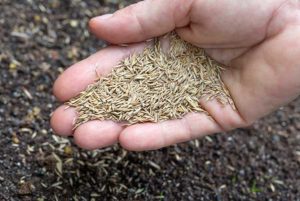
Good rule of thumb is, the more expensive the seed, the better quality it is.
Varieties of grass seed aren’t created equal, and choosing the wrong seed type could create more problems than you are trying to fix. Inexpensive seeds may be more attractive since they keep your costs low, but these lower-quality blends often contain filler seeds and possibly even weed seeds. Find the mix that best suits your climate conditions and the needs of your lawn.
The best sources for grass seeds are reputable manufacturers if you are seeding yourself, or proven, trustworthy lawn care professionals. When you start with quality seeds, it’s much easier to have a quality lawn.
Why You Should Never Use Hay or Straw
One of the critical parts of putting down new grass seed is keeping the soil moist. This is why you often see lawns covered with materials that trap moisture just after seeding. However, you should never cover these newly-seed bare spots with hay or straw.
Hay is made up of grasses, legumes (e.g., alfalfa), and other herbaceous plants that are harvested and dried to be used as animal fodder. Since it is harvested while still living and healthy, it can be full of weed seed heads. Laying hay will spread these seeds right alongside your grass, where they can germinate and grow..
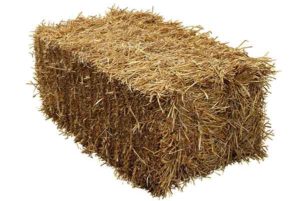
- Straw and hay can be easily confused between production and packaging, and so you can easily be given weed laden hay.
- Straw is lightweight and can blow around your yard, making it look unkempt until you mow.
- Straw risks damaging the young grass, meaning that it must be raked up not long after it is spread.
- Straw can inhibit germination when spread too thickly.
We recommend covering newly seeded bare spots with a thin layer of screened compost, jute germination blankets, or a commercially manufactured seedling mulch containing paper mulch, starter fertilizer, and a tackifier to keep your soil damp or seeds in place.
Overseeding Your Lawn Is Bad
It is true that new seedlings compete with themselves and even other established grass plants if you seed your lawn at excessively high rates. However, not all grasses spread out easily across the lawn to fill in thin and bare areas so overseeding (seeding into a thin, weak existing lawn) is mandatory.

To correctly overseed, you need to start by aerating to improve water and air movement through the soil. This will also help ensure new seed makes its way down to the soil surface instead of simply resting on the grass. Next, cut the existing grass shorter than usual and bag all the grass clippings to keep them off the soil. Once the lawn is appropriately prepared, evenly scatter seed at the manufacturer’s recommended rate for overseeding and water it a couple of times a day to keep the soil moist.
You Cannot Seed After a Fall Frost

Dormant seeding is the process of purposely seeding in late winter or early spring, usually right before a heavy snowfall. Seeding before a snowfall allows the grass seed to be compressed by the snow so that freezing and thawing can move the seed into the soil’s top layers. This cycle of freezing and thawing is called the frost heave.
However, this is not a foolproof method; the greatest risk lies in relying on the weather for heavy snow and the spring for rain. As we know, these are not guaranteed.
Spring Is The Best Time To Plant New Grass Seed
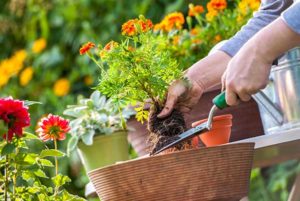
Spring is a popular time to start gardening and lawn care activities.
It’s a common misconception that planting seed in the early spring will give the best results, which makes sense considering that most gardens are planted in the early spring.
The best time for seeding depends on what type of grass you are seeding, warm-season grass (that go dormant/brown) in winter or cool-season grasses.
Cool-season grasses are best seeded in the 1. fall (late Aug-Oct), 2. Spring, 3. Dormant.
Warm-season grasses are best seeding in Late May -Mid July.
Seeding also depends on your location in the country. Those months can change slightly depending on how north or south you are. Sunlight and nutrients don’t really matter for seeding timing.
To better understand this, let’s talk about the growth patterns of cool-season and warm-season grasses and how growth relates to temperature.
Cool-season grasses (tall fescue, Kentucky bluegrass or perennial ryegrass ) can go brown and dormant in the summer if they are not irrigated, whereas warm-season grasses (bermudagrass, zoysiagrass, buffalograss and more) will always go brown and dormant during the cold winter months.
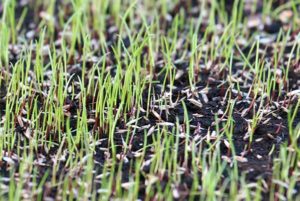
It is always important to match the cool-season or warm-season grasses to your growing region.
Cool-season grasses, like tall fescue, Kentucky bluegrass or perennial ryegrass are grown in climates where summers are temperate and winters are harsh. (e.g., the Midwest). They grow best when temperatures are between 65 and 75°F and must be irrigated in the summer to prevent browning. Since cool-season grasses grow most when temperatures are cooler, it is recommended to plant new seeds to coincide with these temps for optimum germination.
As a rule of thumb, cool-season grasses are best seeded from late August through October, so they have a chance to grow before winter dormancy. The second best time to seed them is spring, followed by utilizing dormant seeding.
If you seed in the spring, the young grass will not have a strongly developed root system when the heat of the summer arrives and without excellent supplemental irrigation, there is a good chance that juvenile spring seedlings will die over the summer. Fall seeding allows the seedlings to spend all of the fall, some of the warmer times of the winter, and all of the spring to grow deep and strong roots to prepare for next summer.
Warm-season grasses, like bermuda grass, zoysia grass or buffalo grass grow in climates where the summers are hot and winters are milder. They grow best when temperatures are between 85°F and 95°F, and go dormant in the winter months. They are best seeded from late-May to mid-July to use the summer heat for developing roots, to better prepare them for the upcoming winter.
Crabgrass Control Cannot Be Applied
It’s been suggested that seeding late in the summer or fall will mean you will have to deal with crabgrass the next year since you should not apply crabgrass controllers when you seed. While it is true that you should not apply crabgrass control in the spring, it is absolutely untrue that you cannot apply any in the fall.
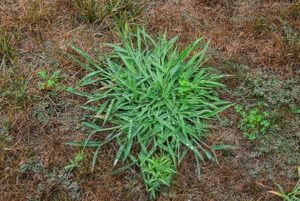
Early in March or April apply a preventative weed killer to keep crabgrass from taking up residence in your lawn. The timing of this application is the most critical part of this method. Soil temperatures need to be cool enough that crabgrass seeds haven’t started to germinate. If you apply too early, the product might not be active once they start.
Don’t worry about controlling established crabgrass in the fall. If you tear up your lawn with aggressive aeration and verticutting, the crabgrass won’t compete and it will all die with the first frost. As soon as the temps start cooling in late-August, crabgrass growth slows down considerably.
Soil Testing Is Not Important
Soil testing is a beneficial—and necessary—part of maintaining a robust lawn. Analyzing your soil’s pH levels and fertility is an essential diagnostic tool that gives you a clear picture of your soil’s health and nutrient deficiencies. You can fine-tune your management practices based on the results.
Your soil’s pH value gives more insight into the soil’s condition than just if it’s acidic, neutral, or alkaline. As the pH value drops too low or climbs too high, it changes the availability of nutrients in the soil. Sometimes it makes them unavailable, and sometimes it releases more compounds to create toxic conditions. Your soil may have a good fertility baseline, but its pH level impacts what is naturally present.
Determining the soil pH and the nutrient content allows you to make the necessary adjustments to correct pH problems for optimum nutrient availability. Coupled with the nutrient analysis, pH values give you specific insights on what your grass needs and what to add to benefit grass growth. This helps save you money by not applying unnecessary fertilizers.
You should test your lawn soil every three to five years. If the pH is significantly out of range and you’re working to amend it, you should test more often to watch the value closely.
For more help, check out our article on soil analysis.
Grass Seed Should Be Buried
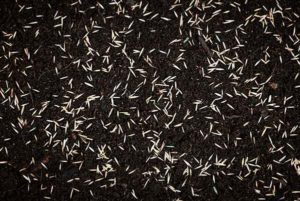
It’s optimal to plant the seeds in the top ½ inch of soil for proper germination. Here they can receive the right amount of soil contact and there is more soil water to keep the seeds more moist.
The best way to cover seed is to gently mix it onto the soil surface using an overturned rake (so the tines are facing upwards), or add a seedling mulch to hold it in place and retain moisture.
Grass Seed Is Hard To Grow
Grass needs to be cared for after it is planted; if you throw down seed and pay no more attention to it, you will fail to grow anything. It’s also challenging to grow if you’re paying attention but caring for it incorrectly. Follow these simple steps to ensure easy, lush growth.
- Prepare the soil. Make sure the pH value is in the correct range, and work the top few inches of the seedbed.
- Plant during the fall or spring months when temperatures are cooler and there is more rain so the soil retains moisture.
- Water the new seed multiple times a day to ensure the soil is consistently moist until you have good germination. Then you can slowly start scaling back on your watering.
- Cover the new seed with seedling mulch if you have problems keeping it moist.
- Mow the grass as soon as it gets tall enough to be mowed. The ideal height for tall fescue is 2.5-3.5 inches, so once it gets to 2.5-3 inches, scale back on the water so the ground is not saturated and get out there and mow.
Don’t Mow New Grass Too Early
Let the grass grow tall so it won’t pull out of the ground. Untrue. Letting it grow tall causes the grass to spend more energy growing upwards, and we want the grass to spend energy spreading out across the lawn.
Lawn Seeding Service From The Experts!
Sometimes, it’s better to call in the professionals than to tackle a project yourself, and seeding a lawn may be one of those times. Given the effort of preparing your lawn, checking pH levels, aligning weed treatments, you might be better off calling in professionals, even if you just need advice on getting started.
Hiring a professional helps to address your lawn’s specific needs and dramatically improves the results. If you’re short on time or looking for professional help seeding your lawn, reach out to us and we would love to help you!
Get a Free Estimate today for help with your lawn seeding needs by a RYAN lawn seeding expert!









